Yangning Li
From Web Search towards Agentic Deep Research: Incentivizing Search with Reasoning Agents
Jun 23, 2025Abstract:Information retrieval is a cornerstone of modern knowledge acquisition, enabling billions of queries each day across diverse domains. However, traditional keyword-based search engines are increasingly inadequate for handling complex, multi-step information needs. Our position is that Large Language Models (LLMs), endowed with reasoning and agentic capabilities, are ushering in a new paradigm termed Agentic Deep Research. These systems transcend conventional information search techniques by tightly integrating autonomous reasoning, iterative retrieval, and information synthesis into a dynamic feedback loop. We trace the evolution from static web search to interactive, agent-based systems that plan, explore, and learn. We also introduce a test-time scaling law to formalize the impact of computational depth on reasoning and search. Supported by benchmark results and the rise of open-source implementations, we demonstrate that Agentic Deep Research not only significantly outperforms existing approaches, but is also poised to become the dominant paradigm for future information seeking. All the related resources, including industry products, research papers, benchmark datasets, and open-source implementations, are collected for the community in https://github.com/DavidZWZ/Awesome-Deep-Research.
A Call for Collaborative Intelligence: Why Human-Agent Systems Should Precede AI Autonomy
Jun 11, 2025Abstract:Recent improvements in large language models (LLMs) have led many researchers to focus on building fully autonomous AI agents. This position paper questions whether this approach is the right path forward, as these autonomous systems still have problems with reliability, transparency, and understanding the actual requirements of human. We suggest a different approach: LLM-based Human-Agent Systems (LLM-HAS), where AI works with humans rather than replacing them. By keeping human involved to provide guidance, answer questions, and maintain control, these systems can be more trustworthy and adaptable. Looking at examples from healthcare, finance, and software development, we show how human-AI teamwork can handle complex tasks better than AI working alone. We also discuss the challenges of building these collaborative systems and offer practical solutions. This paper argues that progress in AI should not be measured by how independent systems become, but by how well they can work with humans. The most promising future for AI is not in systems that take over human roles, but in those that enhance human capabilities through meaningful partnership.
A Survey on Large Language Model based Human-Agent Systems
May 01, 2025Abstract:Recent advances in large language models (LLMs) have sparked growing interest in building fully autonomous agents. However, fully autonomous LLM-based agents still face significant challenges, including limited reliability due to hallucinations, difficulty in handling complex tasks, and substantial safety and ethical risks, all of which limit their feasibility and trustworthiness in real-world applications. To overcome these limitations, LLM-based human-agent systems (LLM-HAS) incorporate human-provided information, feedback, or control into the agent system to enhance system performance, reliability and safety. This paper provides the first comprehensive and structured survey of LLM-HAS. It clarifies fundamental concepts, systematically presents core components shaping these systems, including environment & profiling, human feedback, interaction types, orchestration and communication, explores emerging applications, and discusses unique challenges and opportunities. By consolidating current knowledge and offering a structured overview, we aim to foster further research and innovation in this rapidly evolving interdisciplinary field. Paper lists and resources are available at https://github.com/HenryPengZou/Awesome-LLM-Based-Human-Agent-System-Papers.
From Token to Line: Enhancing Code Generation with a Long-Term Perspective
Apr 10, 2025Abstract:The emergence of large language models (LLMs) has significantly promoted the development of code generation task, sparking a surge in pertinent literature. Current research is hindered by redundant generation results and a tendency to overfit local patterns in the short term. Although existing studies attempt to alleviate the issue by adopting a multi-token prediction strategy, there remains limited focus on choosing the appropriate processing length for generations. By analyzing the attention between tokens during the generation process of LLMs, it can be observed that the high spikes of the attention scores typically appear at the end of lines. This insight suggests that it is reasonable to treat each line of code as a fundamental processing unit and generate them sequentially. Inspired by this, we propose the \textbf{LSR-MCTS} algorithm, which leverages MCTS to determine the code line-by-line and select the optimal path. Further, we integrate a self-refine mechanism at each node to enhance diversity and generate higher-quality programs through error correction. Extensive experiments and comprehensive analyses on three public coding benchmarks demonstrate that our method outperforms the state-of-the-art performance approaches.
MDIT: A Model-free Data Interpolation Method for Diverse Instruction Tuning
Apr 09, 2025Abstract:As Large Language Models (LLMs) are increasingly applied across various tasks, instruction tuning has emerged as a critical method for enhancing model performance. However, current data management strategies face substantial challenges in generating diverse and comprehensive data, restricting further improvements in model performance. To address this gap, we propose MDIT, a novel model-free data interpolation method for diverse instruction tuning, which generates varied and high-quality instruction data by performing task interpolation. Moreover, it contains diversity-based clustering strategies to ensure the diversity of the training data. Extensive experiments show that our method achieves superior performance in multiple benchmark tasks. The LLMs finetuned with MDIT show significant improvements in numerous tasks such as general question answering, math reasoning, and code generation. MDIT offers an efficient and automatic data synthetic method, generating diverse instruction data without depending on external resources while expanding the application potential of LLMs in complex environments.
RAISE: Reinforenced Adaptive Instruction Selection For Large Language Models
Apr 09, 2025Abstract:In the instruction fine-tuning of large language models (LLMs), it has become a consensus that a few high-quality instructions are superior to a large number of low-quality instructions. At present, many instruction selection methods have been proposed, but most of these methods select instruction based on heuristic quality metrics, and only consider data selection before training. These designs lead to insufficient optimization of instruction fine-tuning, and fixed heuristic indicators are often difficult to optimize for specific tasks. So we designed a dynamic, task-objective-driven instruction selection framework RAISE(Reinforenced Adaptive Instruction SElection), which incorporates the entire instruction fine-tuning process into optimization, selecting instruction at each step based on the expected impact of instruction on model performance improvement. Our approach is well interpretable and has strong task-specific optimization capabilities. By modeling dynamic instruction selection as a sequential decision-making process, we use RL to train our selection strategy. Extensive experiments and result analysis prove the superiority of our method compared with other instruction selection methods. Notably, RAISE achieves superior performance by updating only 1\% of the training steps compared to full-data training, demonstrating its efficiency and effectiveness.
TestNUC: Enhancing Test-Time Computing Approaches through Neighboring Unlabeled Data Consistency
Feb 26, 2025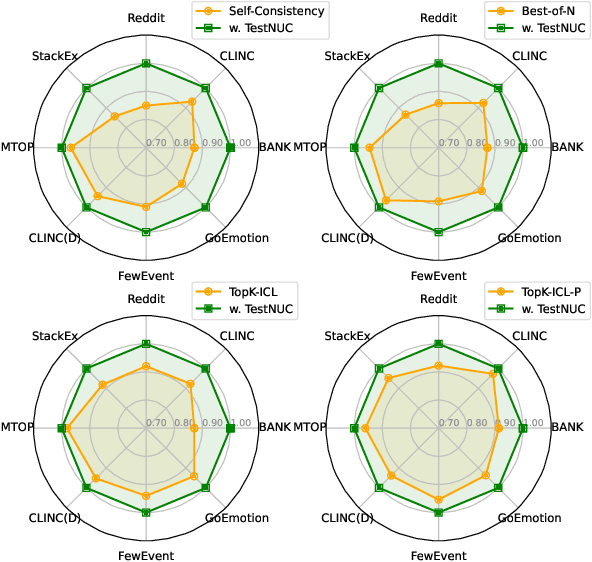
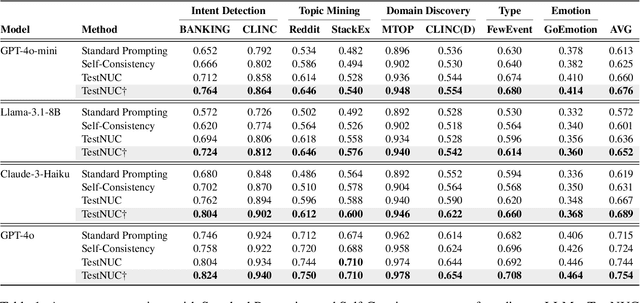
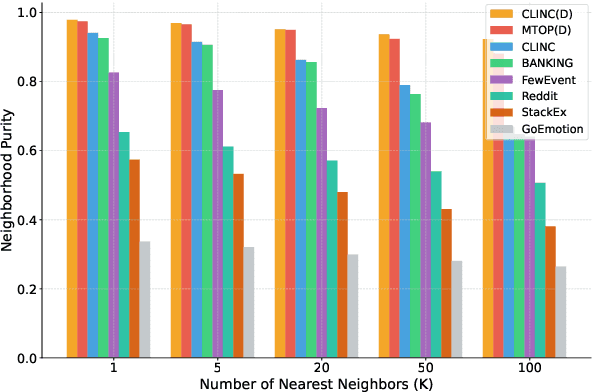
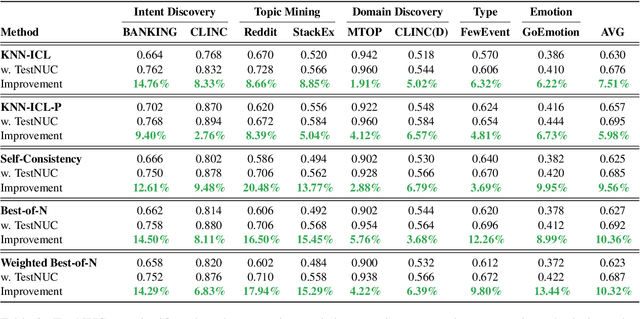
Abstract:Test-time computing approaches, which leverage additional computational resources during inference, have been proven effective in enhancing large language model performance. This work introduces a novel, linearly scaling approach, TestNUC, that improves test-time predictions by leveraging the local consistency of neighboring unlabeled data-it classifies an input instance by considering not only the model's prediction on that instance but also on neighboring unlabeled instances. We evaluate TestNUC across eight diverse datasets, spanning intent classification, topic mining, domain discovery, and emotion detection, demonstrating its consistent superiority over baseline methods such as standard prompting and self-consistency. Furthermore, TestNUC can be seamlessly integrated with existing test-time computing approaches, substantially boosting their performance. Our analysis reveals that TestNUC scales effectively with increasing amounts of unlabeled data and performs robustly across different embedding models, making it practical for real-world applications. Our code is available at https://github.com/HenryPengZou/TestNUC.
DAST: Context-Aware Compression in LLMs via Dynamic Allocation of Soft Tokens
Feb 17, 2025
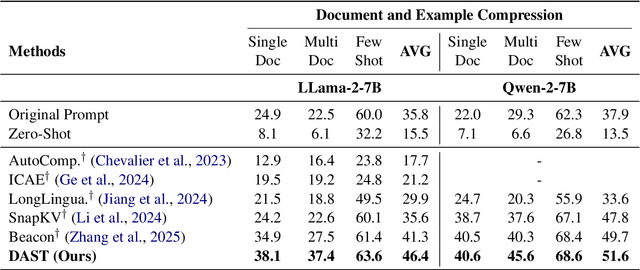

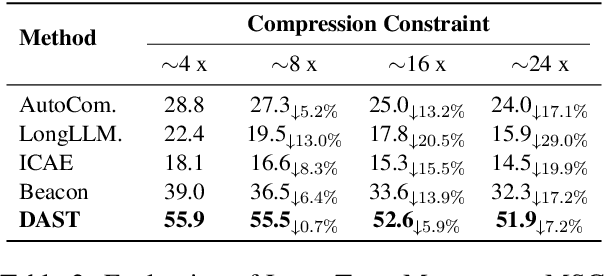
Abstract:Large Language Models (LLMs) face computational inefficiencies and redundant processing when handling long context inputs, prompting a focus on compression techniques. While existing semantic vector-based compression methods achieve promising performance, these methods fail to account for the intrinsic information density variations between context chunks, instead allocating soft tokens uniformly across context chunks. This uniform distribution inevitably diminishes allocation to information-critical regions. To address this, we propose Dynamic Allocation of Soft Tokens (DAST), a simple yet effective method that leverages the LLM's intrinsic understanding of contextual relevance to guide compression. DAST combines perplexity-based local information with attention-driven global information to dynamically allocate soft tokens to the informative-rich chunks, enabling effective, context-aware compression. Experimental results across multiple benchmarks demonstrate that DAST surpasses state-of-the-art methods.
Refine Knowledge of Large Language Models via Adaptive Contrastive Learning
Feb 11, 2025Abstract:How to alleviate the hallucinations of Large Language Models (LLMs) has always been the fundamental goal pursued by the LLMs research community. Looking through numerous hallucination-related studies, a mainstream category of methods is to reduce hallucinations by optimizing the knowledge representation of LLMs to change their output. Considering that the core focus of these works is the knowledge acquired by models, and knowledge has long been a central theme in human societal progress, we believe that the process of models refining knowledge can greatly benefit from the way humans learn. In our work, by imitating the human learning process, we design an Adaptive Contrastive Learning strategy. Our method flexibly constructs different positive and negative samples for contrastive learning based on LLMs' actual mastery of knowledge. This strategy helps LLMs consolidate the correct knowledge they already possess, deepen their understanding of the correct knowledge they have encountered but not fully grasped, forget the incorrect knowledge they previously learned, and honestly acknowledge the knowledge they lack. Extensive experiments and detailed analyses on widely used datasets demonstrate the effectiveness of our method.
Loss-Aware Curriculum Learning for Chinese Grammatical Error Correction
Dec 31, 2024Abstract:Chinese grammatical error correction (CGEC) aims to detect and correct errors in the input Chinese sentences. Recently, Pre-trained Language Models (PLMS) have been employed to improve the performance. However, current approaches ignore that correction difficulty varies across different instances and treat these samples equally, enhancing the challenge of model learning. To address this problem, we propose a multi-granularity Curriculum Learning (CL) framework. Specifically, we first calculate the correction difficulty of these samples and feed them into the model from easy to hard batch by batch. Then Instance-Level CL is employed to help the model optimize in the appropriate direction automatically by regulating the loss function. Extensive experimental results and comprehensive analyses of various datasets prove the effectiveness of our method.
 Add to Chrome
Add to Chrome Add to Firefox
Add to Firefox Add to Edge
Add to Edge